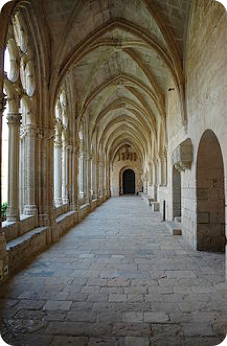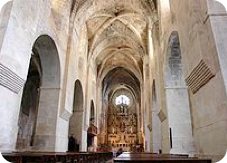
Monastery panoramic view
Foto: Josep Renalias
Foto: Josep Renalias
The cloister, the dome (middle) and the clock tower



Foto: Josep Renalias
A gallery of the cloister

The Royal Monastery of Santa Maria de Santes Creus
The Royal Monastery of Santa Maria de Santes Creus is one of the gems of medieval Catalunya and is located in the town of Santes Creus, capital of the municipality of Aiguamúrcia (Alt Camp). Today is the only monastery of the Cistercian ruta that don't have life monastic.
The origin of the monastery dates back to 1150 but not in the current enclave. The powerful family Montcada at that time ceded at the monks of the Abbey cistersenses Grand Selva (Llenguadoc) some land at a place called Valdaura, in the present municipality of Cerdanyola del Vallés Barcelona, and settled there temporarily.
In 1158 the lords of Montagut and Albá made donations the hamlet of Santes Creus, the rich side of Gaya, and decided to change the settlement. However, a jurisdictional dispute between the diocese of Barcelona and Tarragona, the transfer was delayed until Pope Alexander II decreed the independence of the monastery in 1168.
Finally, in 1174 was able to start construction of the monastic complex: first, the church and the chapter, after which the now defunct original Romanesque cloister, later, the room of the monks, the refectory and the dormitory.
By 1225 the main units were completed. In the middle of the thirteenth century the Aragonese monarchy interfered with the pace of the Abbey showing interest in it which in turn disrupted the simplicity of monastic life cistersense and enlarged the monastic complex with significant new construction. Is a time of Abbot Sant Bernard Calvó, counselor of Jaume I el Conqueridor (1213-1276), who accompanied in the conquest of Mallorca and Valencia.
The successor to the Crown, Pere III el Gran (1276-1285), dispensed the royal patronage to the abbey and wanted to be buried there, as would later his son Jaume II (1291-1337) and his wife, Blanca de Anjou. At the request of the latter monarch rooms abbey became a royal palace, and his will be the demolition of the Romanesque cloister to be replaced by the present Gothic, designed by the English master of Fonoll Reinard and Guillem to follow, and the construction of the dome over the transept of the church.
Must attribute the walled monastic enclosure Pere IV el Ceremoniós (1336-1387) and also because of its predilection for the monastery of Poblet, Santes Creus the stop being real pantheon palace in favor of that, hence , the palatial rooms used again by abbey.
During the seventeenth and eighteenth centuries are still made extension and renovation works, adding new outbuildings. This ongoing activity is truncated abruptly in 1835 with the "confiscation of Mendizabal", when the monastery suffered the abandonment by the Cistercian community is doomed to ruin. National Monument in 1921, has been amended several restoration and refurbishment and is today the place of cultural events of various kinds under management of the Generalitat de Catalunya.
Foto: Josep Renalias
The bedroom
Foto: Josep Renalias
The chapter house, with seven tablets of the abbots in the ground


Foto: Josep Renalias
Interior of the church, and in the background, baroque retable
of Josep Tremulles
Foto: Josep Renalias
In the background facade of the church. In the foreground, the fountain of the late baroque, 18th century,
Sant Bernat Calbó












